2019 JEEP GRAND CHEROKEE LIMITED air conditioning
[x] Cancel search: air conditioningPage 96 of 626
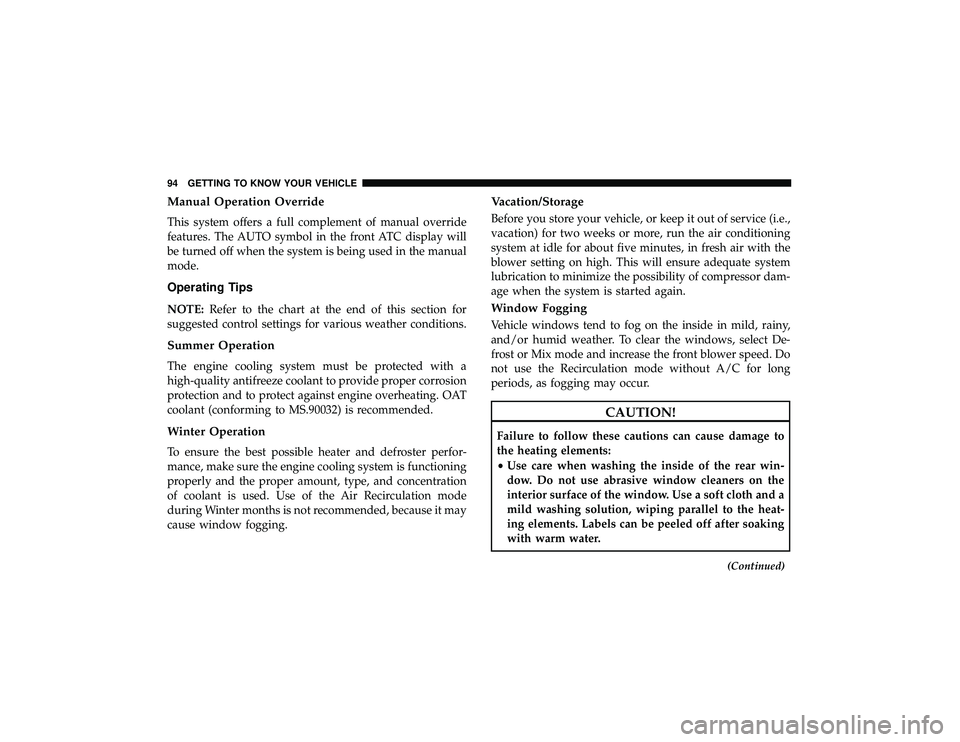
Manual Operation Override
This system offers a full complement of manual override
features. The AUTO symbol in the front ATC display will
be turned off when the system is being used in the manual
mode.
Operating Tips
NOTE:Refer to the chart at the end of this section for
suggested control settings for various weather conditions.
Summer Operation
The engine cooling system must be protected with a
high-quality antifreeze coolant to provide proper corrosion
protection and to protect against engine overheating. OAT
coolant (conforming to MS.90032) is recommended.
Winter Operation
To ensure the best possible heater and defroster perfor-
mance, make sure the engine cooling system is functioning
properly and the proper amount, type, and concentration
of coolant is used. Use of the Air Recirculation mode
during Winter months is not recommended, because it may
cause window fogging.
Vacation/Storage
Before you store your vehicle, or keep it out of service (i.e.,
vacation) for two weeks or more, run the air conditioning
system at idle for about five minutes, in fresh air with the
blower setting on high. This will ensure adequate system
lubrication to minimize the possibility of compressor dam-
age when the system is started again.
Window Fogging
Vehicle windows tend to fog on the inside in mild, rainy,
and/or humid weather. To clear the windows, select De-
frost or Mix mode and increase the front blower speed. Do
not use the Recirculation mode without A/C for long
periods, as fogging may occur.
Page 377 of 626
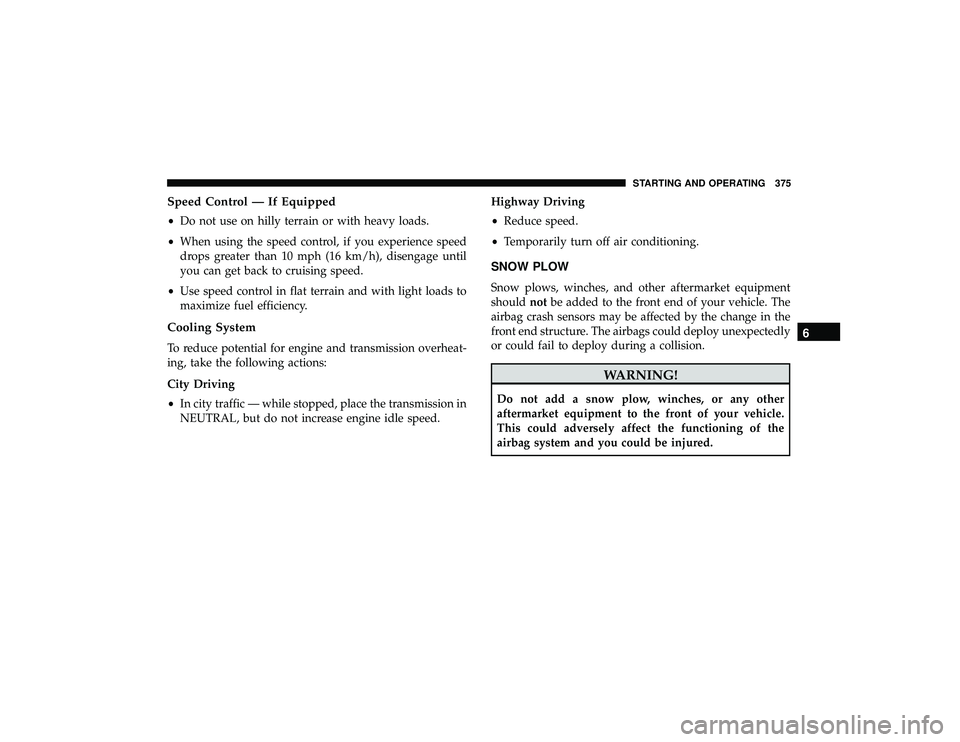
Speed Control — If Equipped
•Do not use on hilly terrain or with heavy loads.
• When using the speed control, if you experience speed
drops greater than 10 mph (16 km/h), disengage until
you can get back to cruising speed.
• Use speed control in flat terrain and with light loads to
maximize fuel efficiency.
Cooling System
To reduce potential for engine and transmission overheat-
ing, take the following actions:
City Driving
•In city traffic — while stopped, place the transmission in
NEUTRAL, but do not increase engine idle speed. Highway Driving
•
Reduce speed.
• Temporarily turn off air conditioning.
SNOW PLOW
Snow plows, winches, and other aftermarket equipment
should notbe added to the front end of your vehicle. The
airbag crash sensors may be affected by the change in the
front end structure. The airbags could deploy unexpectedly
or could fail to deploy during a collision.
Page 412 of 626
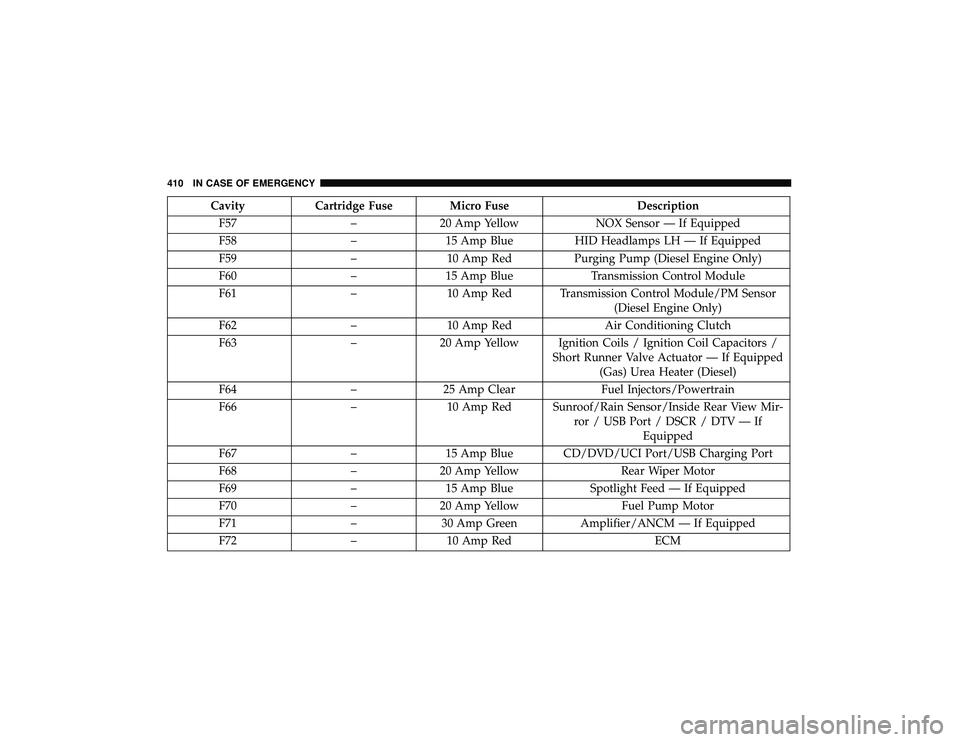
CavityCartridge Fuse Micro Fuse Description
F57 –20 Amp Yellow NOX Sensor — If Equipped
F58 –15 Amp Blue HID Headlamps LH — If Equipped
F59 –10 Amp Red Purging Pump (Diesel Engine Only)
F60 –15 Amp Blue Transmission Control Module
F61 –10 Amp Red Transmission Control Module/PM Sensor
(Diesel Engine Only)
F62 –10 Amp Red Air Conditioning Clutch
F63 –20 Amp Yellow Ignition Coils / Ignition Coil Capacitors /
Short Runner Valve Actuator — If Equipped(Gas) Urea Heater (Diesel)
F64 –25 Amp Clear Fuel Injectors/Powertrain
F66 –10 Amp Red Sunroof/Rain Sensor/Inside Rear View Mir-
ror / USB Port / DSCR / DTV — IfEquipped
F67 –15 Amp Blue CD/DVD/UCI Port/USB Charging Port
F68 –20 Amp Yellow Rear Wiper Motor
F69 –15 Amp Blue Spotlight Feed — If Equipped
F70 –20 Amp Yellow Fuel Pump Motor
F71 –30 Amp Green Amplifier/ANCM — If Equipped
F72 –10 Amp Red ECM
410 IN CASE OF EMERGENCY
Page 441 of 626
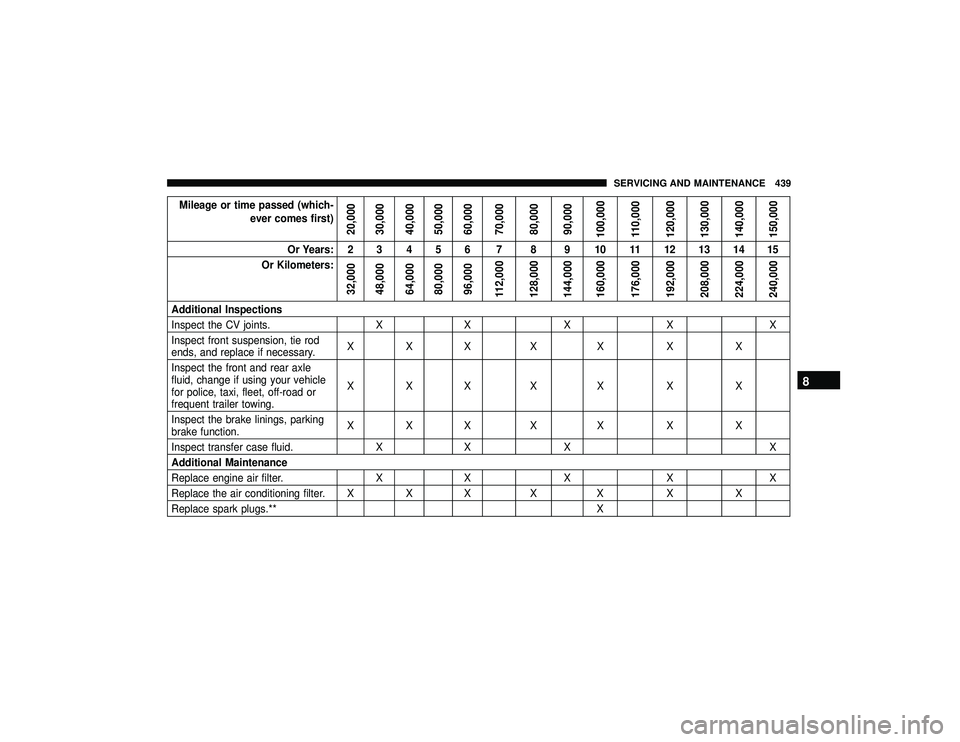
Mileage or time passed (which-ever comes first)
20,000
30,000
40,000
50,000
60,000
70,000
80,000
90,000
100,000
110,000
120,000
130,000
140,000
150,000
Or Years: 2 3 4 5 6 7 8 9 10 11 12 13 14 15
Or Kilometers:
32,000
48,000
64,000
80,000
96,000
112,000
128,000
144,000
160,000
176,000
192,000
208,000
224,000
240,000
Additional Inspections
Inspect the CV joints. X X X X X
Inspect front suspension, tie rod
ends, and replace if necessary. XXX X X X X
Inspect the front and rear axle
fluid, change if using your vehicle
for police, taxi, fleet, off-road or
frequent trailer towing. XXX X X X X
Inspect the brake linings, parking
brake function. XXX X X X X
Inspect transfer case fluid. X X X X
Additional Maintenance
Replace engine air filter. X X X X X
Replace the air conditioning filter. X X X X X X X
Replace spark plugs.** X
8
SERVICING AND MAINTENANCE 439
Page 453 of 626
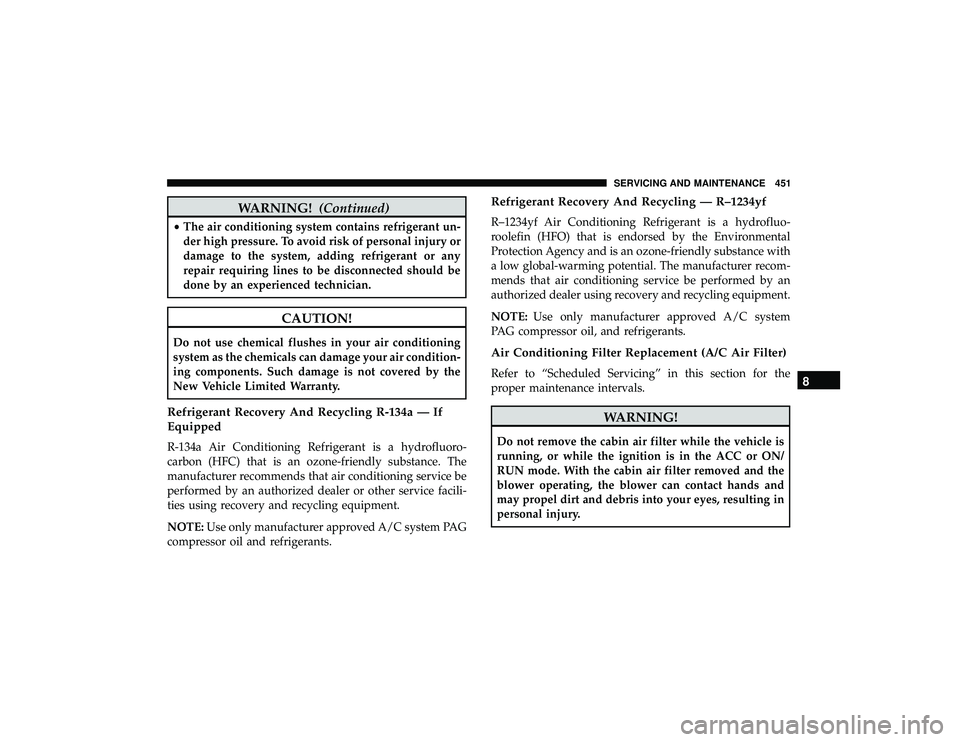
WARNING!(Continued)
•The air conditioning system contains refrigerant un-
der high pressure. To avoid risk of personal injury or
damage to the system, adding refrigerant or any
repair requiring lines to be disconnected should be
done by an experienced technician.
CAUTION!
Do not use chemical flushes in your air conditioning
system as the chemicals can damage your air condition-
ing components. Such damage is not covered by the
New Vehicle Limited Warranty.
Refrigerant Recovery And Recycling R-134a — If
Equipped
R-134a Air Conditioning Refrigerant is a hydrofluoro-
carbon (HFC) that is an ozone-friendly substance. The
manufacturer recommends that air conditioning service be
performed by an authorized dealer or other service facili-
ties using recovery and recycling equipment.
NOTE: Use only manufacturer approved A/C system PAG
compressor oil and refrigerants.
Refrigerant Recovery And Recycling — R–1234yf
R–1234yf Air Conditioning Refrigerant is a hydrofluo-
roolefin (HFO) that is endorsed by the Environmental
Protection Agency and is an ozone-friendly substance with
a low global-warming potential. The manufacturer recom-
mends that air conditioning service be performed by an
authorized dealer using recovery and recycling equipment.
NOTE: Use only manufacturer approved A/C system
PAG compressor oil, and refrigerants.
Air Conditioning Filter Replacement (A/C Air Filter)
Refer to “Scheduled Servicing” in this section for the
proper maintenance intervals.
Page 468 of 626
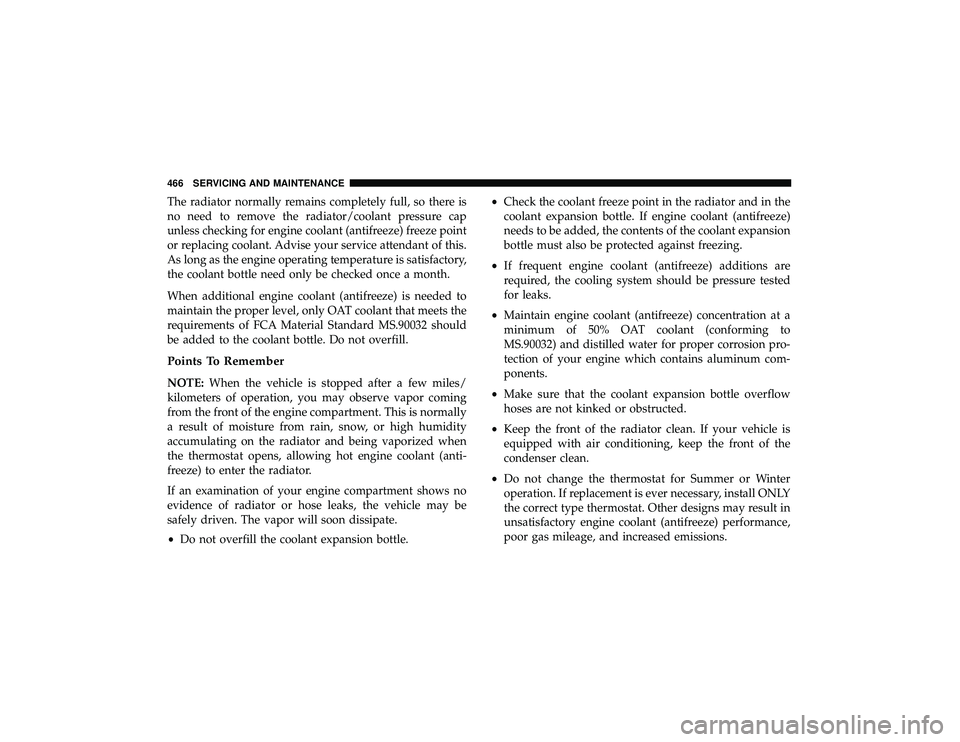
The radiator normally remains completely full, so there is
no need to remove the radiator/coolant pressure cap
unless checking for engine coolant (antifreeze) freeze point
or replacing coolant. Advise your service attendant of this.
As long as the engine operating temperature is satisfactory,
the coolant bottle need only be checked once a month.
When additional engine coolant (antifreeze) is needed to
maintain the proper level, only OAT coolant that meets the
requirements of FCA Material Standard MS.90032 should
be added to the coolant bottle. Do not overfill.
Points To Remember
NOTE:When the vehicle is stopped after a few miles/
kilometers of operation, you may observe vapor coming
from the front of the engine compartment. This is normally
a result of moisture from rain, snow, or high humidity
accumulating on the radiator and being vaporized when
the thermostat opens, allowing hot engine coolant (anti-
freeze) to enter the radiator.
If an examination of your engine compartment shows no
evidence of radiator or hose leaks, the vehicle may be
safely driven. The vapor will soon dissipate.
• Do not overfill the coolant expansion bottle. •
Check the coolant freeze point in the radiator and in the
coolant expansion bottle. If engine coolant (antifreeze)
needs to be added, the contents of the coolant expansion
bottle must also be protected against freezing.
• If frequent engine coolant (antifreeze) additions are
required, the cooling system should be pressure tested
for leaks.
• Maintain engine coolant (antifreeze) concentration at a
minimum of 50% OAT coolant (conforming to
MS.90032) and distilled water for proper corrosion pro-
tection of your engine which contains aluminum com-
ponents.
• Make sure that the coolant expansion bottle overflow
hoses are not kinked or obstructed.
• Keep the front of the radiator clean. If your vehicle is
equipped with air conditioning, keep the front of the
condenser clean.
• Do not change the thermostat for Summer or Winter
operation. If replacement is ever necessary, install ONLY
the correct type thermostat. Other designs may result in
unsatisfactory engine coolant (antifreeze) performance,
poor gas mileage, and increased emissions.
466 SERVICING AND MAINTENANCE
Page 610 of 626
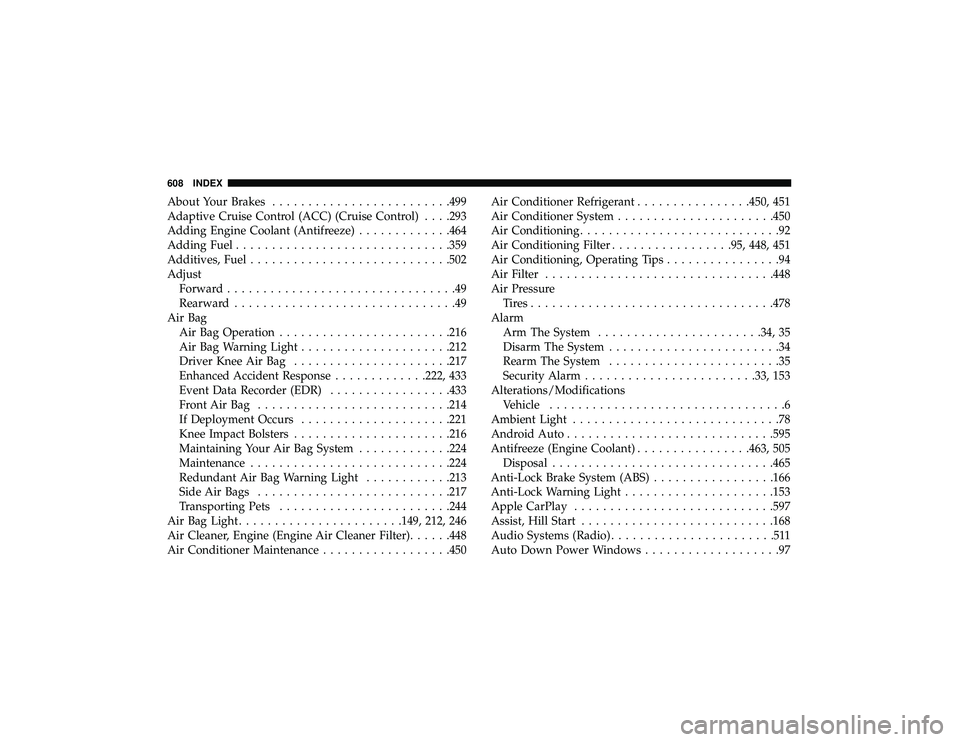
About Your Brakes........................ .499
Adaptive Cruise Control (ACC) (Cruise Control) . . . .293
Adding Engine Coolant (Antifreeze) .............464
Adding Fuel ............................. .359
Additives, Fuel ........................... .502
Adjust Forward ................................49
Rearward ...............................49
Air Bag Air Bag Operation ....................... .216
Air Bag Warning Light .....................212
Driver Knee Air Bag ..................... .217
Enhanced Accident Response .............222, 433
Event Data Recorder (EDR) .................433
FrontAirBag .......................... .214
If Deployment Occurs .....................221
Knee Impact Bolsters ..................... .216
Maintaining Your Air Bag System .............224
Maintenance ........................... .224
Redundant Air Bag Warning Light ............213
Side Air Bags .......................... .217
Transporting Pets ....................... .244
Air Bag Light .......................149, 212, 246
Air Cleaner, Engine (Engine Air Cleaner Filter) ......448
Air Conditioner Maintenance ..................450 Air Conditioner Refrigerant
................450, 451
Air Conditioner System ..................... .450
Air Conditioning ............................92
Air Conditioning Filter .................95, 448, 451
Air Conditioning, Operating Tips ................94
Air Filter ............................... .448
Air Pressure Tires................................. .478
Alarm Arm The System .......................34, 35
Disarm The System ........................34
Rearm The System ........................35
Security Alarm....................... .33, 153
Alterations/Modifications Vehicle .................................6
Ambient Light .............................78
Andr oid
Auto ............................ .595
Antifreeze (Engine Coolant) ................463, 505
Disposal .............................. .465
Anti-Lock Brake System (ABS) .................166
Anti-Lock Warning Light .....................153
Apple CarPlay ........................... .597
Assist, Hill Start .......................... .168
Audio Systems (Radio) .......................511
Auto Down Power Windows ...................97
608 INDEX
Page 614 of 626
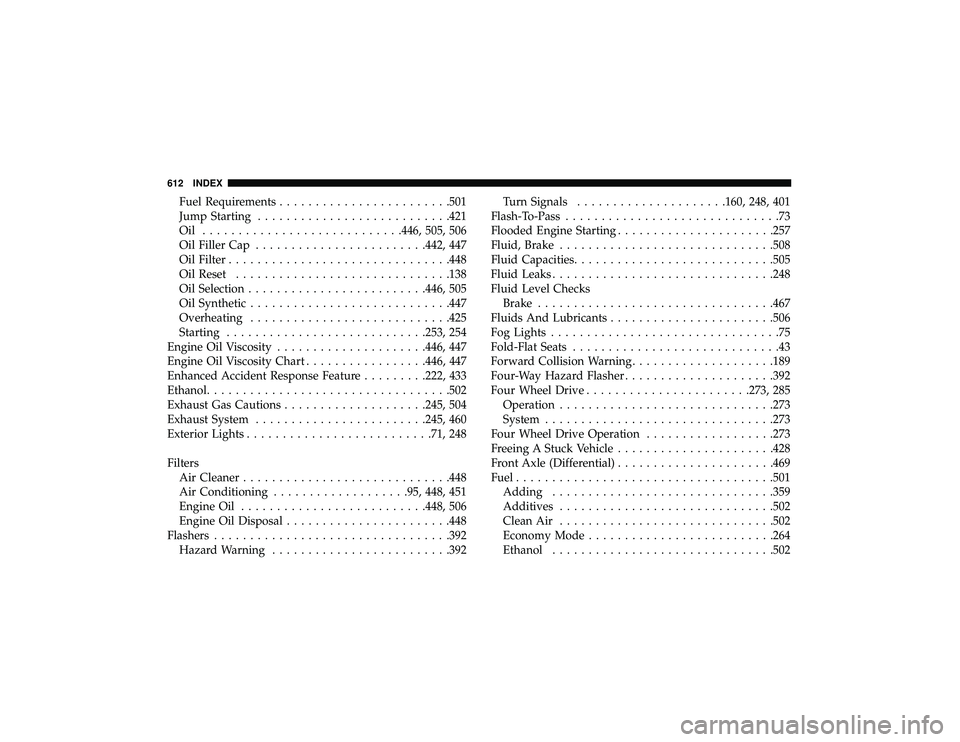
Fuel Requirements....................... .501
Jump Starting .......................... .421
Oil ........................... .446, 505, 506
Oil Filler Cap ....................... .442, 447
Oil Filter .............................. .448
Oil Reset ............................. .138
Oil Selection ........................ .446, 505
Oil Synthetic ........................... .447
Overheating ........................... .425
Starting ........................... .253, 254
Engine Oil Viscosity .....................446, 447
Engine Oil Viscosity Chart .................446, 447
Enhanced Accident Response Feature .........222, 433
Ethanol ................................. .502
Exhaust Gas Cautions ................... .245, 504
Exhaust System ....................... .245, 460
Exterior Lights ......................... .71, 248
Filters Air Cleaner ............................ .448
Air Conditioning .................. .95, 448, 451
Engine Oil ......................... .448, 506
Engine Oil Disposal .......................448
Flashers ................................ .392
Hazard Warning ........................ .392Turn Signals
.....................160, 248, 401
Flash-To-Pass ..............................73
Flooded Engine Starting ..................... .257
Fluid, Brake ............................. .508
Fluid Capacities ........................... .505
Fluid Leaks .............................. .248
Fluid Level Checks Brake ................................ .467
Fluids And Lubricants .......................506
Fog Lights ................................75
Fold-Flat Seats .............................43
Forward Collision Warning ....................189
Four-Way Hazard Flasher .....................392
Four Wheel
Drive .......................273, 285
Operation ............................. .273
System ............................... .273
Four Wheel Drive Operation ..................273
Freeing A Stuck Vehicle ..................... .428
Front Axle (Differential) ..................... .469
Fuel ................................... .501
Adding .............................. .359
Additives ............................. .502
Clean Air ............................. .502
Economy Mode ......................... .264
Ethanol .............................. .502
612 INDEX